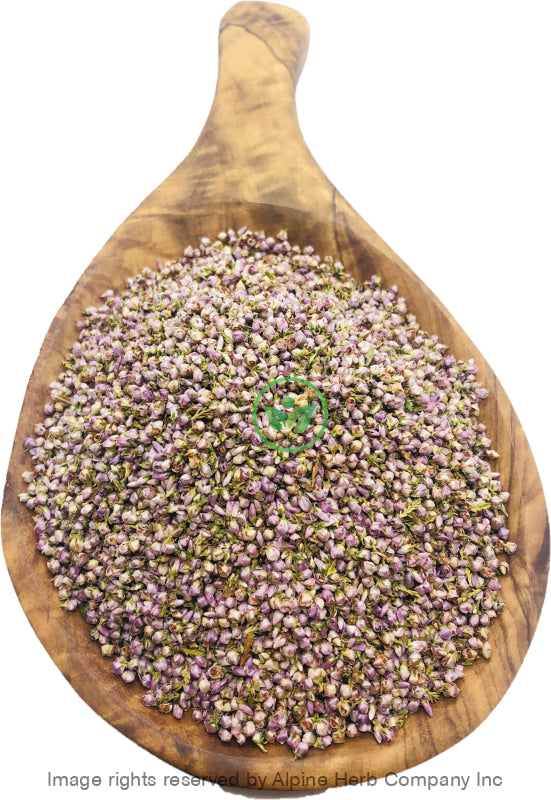Heather Flower Whole Alpine Herb Company Inc.
$ 11,99 $ 7,19
Botanical Name: Calluna vulgaris
Common Name:
- English: Common Heather
- Also, known as: Broom heather, Scotch heather, True Heather, Ling, Brande, Heidekraut, Breyo, Brendolo, Weresk, Liung, Common ling, Lyng, Beitilyng , and Fraoch
Habitat: Europe and Asia
Origin: Poland / Ukraine
Harvested: Wild or cultivated
Parts Used: Flower
General Information:
Calluna vulgaris is an evergreen shrub of the Ericaceae family growing to 2-3 feet in height. It has numerous branching stems and can grow up to 2 feet in length. Leaves are small needle-shaped, typically gray to green in spring and summer but acquire bronze to purple tones in fall and winter. Rose pink to purplish pink flowers in terminal, one-sided, spike-like racemes appear in mid to late summer. Flowers are usually purple but can also be white. While the most common color associated with wild heather is purple, the plant has been cultivated into different colors including white, pink, a wide range of purples and even red. Each heather flower contains about 30 seeds, and in one season a single plant can produce more than 150,000 seeds. The Royal Horticultural Society currently lists over 800 cultivars of this species.
Heather is known for its hardiness and its ability to thrive in areas with poor, rocky soil and extreme temperatures. For this reason, the heather plant played an important historical role in daily life, as it was used as thatch for roofing, bedding, fuel, and the making of brooms, baskets, and rope. Although heather still grows wild in many parts of the world, it has also been cultivated as a garden and landscaping plant.
Calluna vulgaris, deriving from the Greek word “Kallune,” meaning “to clean or brush” and the Latin “vulgaris,” which means “common.” In the past wild heather was often made into brooms for sweeping, and that it is very common plant in the regions where it grows.
How to use:
Hot Infusion:
The basic method for dried herbs and flower is, take 2-3 tablespoons of dried herb in a cup or teapot. Pour hot water over it and cover it with lid for 10-30 minutes. Hot water is needed to draw out the antioxidants, enzymes, vitamins, flavonoids, and volatile oils from the botanicals. Strain and squeeze out as much as liquid as possible and enjoy!
Tips:
- You can sweeten your herbal tea with a bit of honey, natural fruit juice, stevia leaves powder and or licorice root powder.
- You can make ice cubes or pops by freezing tea in ice trays or pop molds.
Precautions:
You should consult with a qualified healthcare practitioner before using any herbal products, particularly if you are pregnant, nursing, or on any medications.
All information on this website is for educational purposes ONLY.
This information has not been evaluated by Health Canada.
This information is not intended to diagnose, treat, cure, or prevent any disease.
| Unit Size | 100g, 200g, 400g, 1kg |
|---|
Prompt shipping and expert packing
Thanks to our longstanding association with UPS FedEx DHL as well as other leading global carriers, we can offer a variety shipping options. Our warehouse staff is highly trained and will be able to pack your goods in accordance with our precise and exact specifications. Your items will go through an exhaustive examination before they will be securely packaged before being delivered. We ship to hundreds of thousands of customers daily in different countries. This is a sign of our determination to become the largest online retailer worldwide. Warehouses and distribution centers are located throughout Europe as well as in the USA.
Note that orders containing multiple items are processed according to the particular item.
We will thoroughly inspect all items ordered before shipping. Most orders are shipped within 48 hours. The delivery time will be between 3 and 7 working days.
Returns
The stock market is always changing. It's not entirely managed by us since we're involved with several entities, including the factory and the storage. Therefore, the actual inventory could fluctuate at any moment. Please be aware that it is possible that your order could be out of stock after you've placed your order.
Our policy lasts for 30 days. If it's been more than 30 days since the date you purchased your item We're sorry to say that we can't offer you a full exchange or refund.
You can only return a product if it is unused and still in the same state as when you received it. The item should be in the original packaging.
Related products
Herb Whole
Herb Whole
Herb Whole
Herb Whole
Herb Whole
Herb Whole
Herb Whole
Herb Whole
Herb Whole
Herb Whole
Herb Whole
Herb Whole
Herb Whole
Herb Whole
Herb Whole
Herb Whole



































